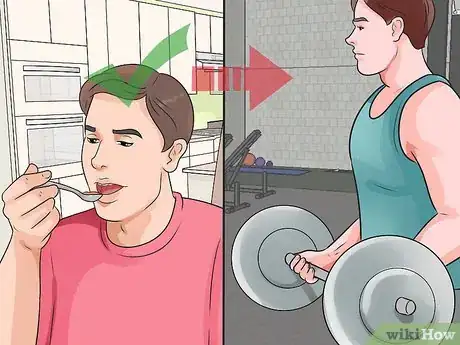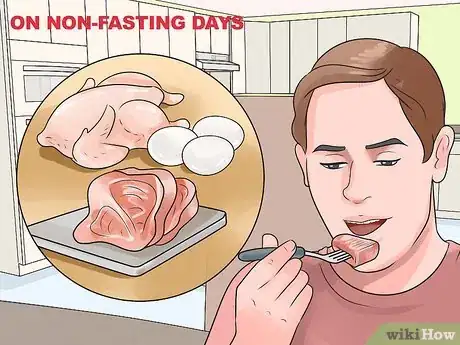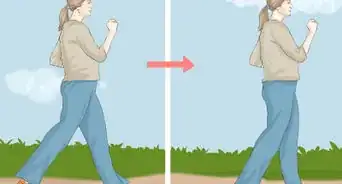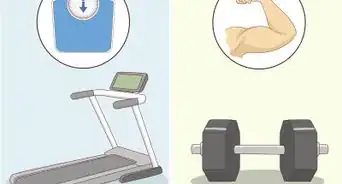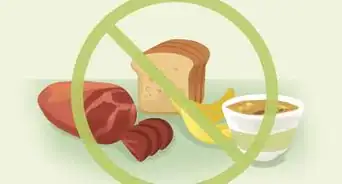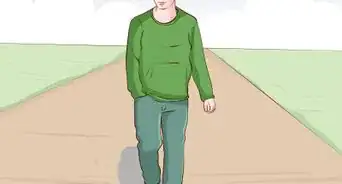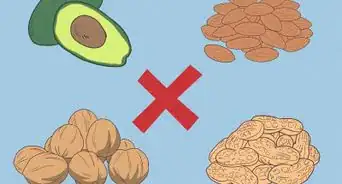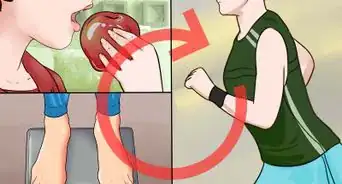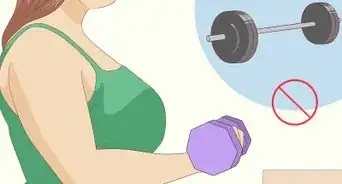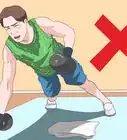This article was co-authored by Chris M. Matsko, MD. Dr. Chris M. Matsko is a retired physician based in Pittsburgh, Pennsylvania. With over 25 years of medical research experience, Dr. Matsko was awarded the Pittsburgh Cornell University Leadership Award for Excellence. He holds a BS in Nutritional Science from Cornell University and an MD from the Temple University School of Medicine in 2007. Dr. Matsko earned a Research Writing Certification from the American Medical Writers Association (AMWA) in 2016 and a Medical Writing & Editing Certification from the University of Chicago in 2017.
This article has been viewed 125,911 times.
People fast for a variety of reasons including religious observance, weight loss and cleansing purposes. If you exercise regularly, you may want to continue with your workout routine; however, fasting means you consume far fewer calories than you'd typically eat in a day, which can make exercise difficult and even unsafe. Understanding the basics of how to do modified exercise during a fast, will help you stay active while staying safe.
Steps
Exercising While Fasting
-
1Consult your physician. You should see your doctor before beginning any exercise routine, but even more so when fasting. Your doctor knows your medical history and can provide guidelines specific to you.
- Talk to your doctor about your desire to fast and your exercise plan. They will be able to tell you if this combination is safe and appropriate for you.
- If you have any pain or discomfort while exercising or side effects of fasting, discontinue the fast and exercise and call your doctor immediately.
- Your doctor's major concern will likely be whether or not your heart is healthy enough for exercise while fasting.
- Nutritionist's recommend not going below 1,200 calories a day when dieting/fasting, especially if you are active.
-
2Opt for a less vigorous workout. A low-intensity exercise may be more beneficial if you're fasting. This may help ensure that your body doesn't use protein for fuel.[1]
- During a fast, your body relies on stored energy in the form of glycogen (your body's storage form of glucose). If you haven't eaten in awhile, you may be running low on glycogen which will force your body to use protein as fuel.[2]
- Choose exercises like walking instead of running. Moderate walking is a low-intensity way to stimulate your heart rate.
- Do light yoga or Tai Chi. Slow, deliberate movements not only balance and stimulate the body, these ancient practices have been known to calm and clear the mind.
- Garden or do light yard work. They require bending, stretching and lifting, among other body movements. Both are basically exercise disguised as a hobby or a fun chore.
- If at any point, even during low-intensity physical activity, you feel lightheaded or dizzy, discontinue the exercise immediately. You may need to drink water and eat a small meal to help you feel better.
Advertisement -
3Include higher intensity exercises after eating. If you're following an intermittent fasting program or a fasting diet for weight loss, you can still include more vigorous intensity exercise.
- Ramping up in the intensity or frequency of your exercise program is possible, but it's best to to do this on the days you've eaten.[3]
- After meals or snacks your body has had the chance to replace its primary fuel of glycogen. You'll also have a more steady supply of glucose in your body from your recently eaten meals or snacks.[4]
- Some experts recommend only doing your higher intensity workouts immediately after meals to help ensure you have enough fuel (carbohydrates) to last you throughout your workout.[5]
Managing Healthy Fasting
-
1Eat protein on non-fasting days. If you're following an alternating fasting plan or are trying to lose weight by fasting, it's recommended to eat a higher amount of protein on your non-fasting days.[6]
- Higher amounts of protein is especially important if you're attempting to build muscle mass. Health experts recommend consuming multiple small, high protein meals every three to four hours.[7]
- According to the Institute of Medicine, the recommended daily intake of protein should be 46 grams and 56 grams for men and women, respectively. Try and boost your protein intake to the max.
- Consuming about 3 – 4 ounces of lean protein will provide you with about 20 – 25 grams of protein.[8]
-
2Drink water. Unless your fast includes abstaining from water, it's essential to avoid dehydration when exercising.
- Adequate hydration is important for your body's normal, daily functioning. Generally, most health professionals will recommend you consume anywhere from eight to 13 8-oz glasses (2 to 3 liters) of water daily.[9]
- Most fasts will allow you to have water (even fasts for medical exams or tests). Make sure to ask or review your fasting plan to see what you can and cannot have as far as hydrating fluids.
-
3Have a realistic exercise plan. You may want to run instead of walk, or think you can handle heavy weight-lifting, but fasting changes the limits of what your body can normally do.
- If you need to fast for a medical exam or a religious observance, plan to include regular low-intensity exercise as you feel able. Once your fast ends, you'll be able to return to your normal activity routine.
- If you are fasting from sun-up to sundown, you may want to avoid exercise during those hours. Instead, exercise close to when you can eat in the early morning or in the evening.
- If you're fasting for weight loss or other nutrition related goals, you'll need to carefully plan in physical activity. This means understanding you'll need to do more low-intensity exercise on your fasting days and only commit to doing higher intensity exercise on days that you consume more calories.
Expert Q&A
-
QuestionIf water fasting, what are the best type of exercises to do to diminish pressure in my lower body organs and promote healthy elimination?
 Chris M. Matsko, MDDr. Chris M. Matsko is a retired physician based in Pittsburgh, Pennsylvania. With over 25 years of medical research experience, Dr. Matsko was awarded the Pittsburgh Cornell University Leadership Award for Excellence. He holds a BS in Nutritional Science from Cornell University and an MD from the Temple University School of Medicine in 2007. Dr. Matsko earned a Research Writing Certification from the American Medical Writers Association (AMWA) in 2016 and a Medical Writing & Editing Certification from the University of Chicago in 2017.
Chris M. Matsko, MDDr. Chris M. Matsko is a retired physician based in Pittsburgh, Pennsylvania. With over 25 years of medical research experience, Dr. Matsko was awarded the Pittsburgh Cornell University Leadership Award for Excellence. He holds a BS in Nutritional Science from Cornell University and an MD from the Temple University School of Medicine in 2007. Dr. Matsko earned a Research Writing Certification from the American Medical Writers Association (AMWA) in 2016 and a Medical Writing & Editing Certification from the University of Chicago in 2017.
Family Medicine Physician Walking is a alway a great exercise and does not put pressure on the lower body organs.
Walking is a alway a great exercise and does not put pressure on the lower body organs. -
QuestionI am 283.4 lbs and I want to lose 40 pounds. Could I do that with a fast?
 Chris M. Matsko, MDDr. Chris M. Matsko is a retired physician based in Pittsburgh, Pennsylvania. With over 25 years of medical research experience, Dr. Matsko was awarded the Pittsburgh Cornell University Leadership Award for Excellence. He holds a BS in Nutritional Science from Cornell University and an MD from the Temple University School of Medicine in 2007. Dr. Matsko earned a Research Writing Certification from the American Medical Writers Association (AMWA) in 2016 and a Medical Writing & Editing Certification from the University of Chicago in 2017.
Chris M. Matsko, MDDr. Chris M. Matsko is a retired physician based in Pittsburgh, Pennsylvania. With over 25 years of medical research experience, Dr. Matsko was awarded the Pittsburgh Cornell University Leadership Award for Excellence. He holds a BS in Nutritional Science from Cornell University and an MD from the Temple University School of Medicine in 2007. Dr. Matsko earned a Research Writing Certification from the American Medical Writers Association (AMWA) in 2016 and a Medical Writing & Editing Certification from the University of Chicago in 2017.
Family Medicine Physician I do not recommend going under 1,200 — 1,400 calories a day, unless you are under the supervision of a doctor.
I do not recommend going under 1,200 — 1,400 calories a day, unless you are under the supervision of a doctor.
Warnings
- If you feel any of the following symptoms, stop exercising and seek medical attention:
- Severe breathlessness
- Lightheadedness or dizziness
- Sudden loss of vision or hearing
- Loss of muscle control
- Severe fatigue
- Nausea or vomiting
- Excessive perspiration
⧼thumbs_response⧽
References
- ↑ http://www.cnn.com/2014/12/30/health/dailyburn-exercise-empty/
- ↑ http://www.cnn.com/2014/12/30/health/dailyburn-exercise-empty/
- ↑ http://www.cnn.com/2014/12/30/health/dailyburn-exercise-empty/
- ↑ http://www.cnn.com/2014/12/30/health/dailyburn-exercise-empty/
- ↑ http://www.cnn.com/2014/12/30/health/dailyburn-exercise-empty/
- ↑ http://www.cnn.com/2014/12/30/health/dailyburn-exercise-empty/
- ↑ http://www.cnn.com/2014/12/30/health/dailyburn-exercise-empty/
- ↑ www.choosemyplate.gov/protein-foods
- ↑ http://www.mayoclinic.org/healthy-lifestyle/nutrition-and-healthy-eating/in-depth/water/art-20044256
About This Article
If you want to exercise while fasting, make sure to consult your physician first, so they can advise you on how to create a safe and effective plan. Since your body will be relying on stored energy during your fast, opt to do a less vigorous workout, such as light yoga, Tai Chi, gardening, or going for a walk. However, if you feel dizzy or lightheaded at any point, stop immediately and eat something or drink some water. On non-fasting days, you can do higher intensity exercises, as long as you do them right after eating. You may also want to try to eat more protein on your non-fasting days, if you want to build muscle mass. For more advice from our Medical co-author, including how to create a realistic exercise plan for when you're fasting, scroll down!


